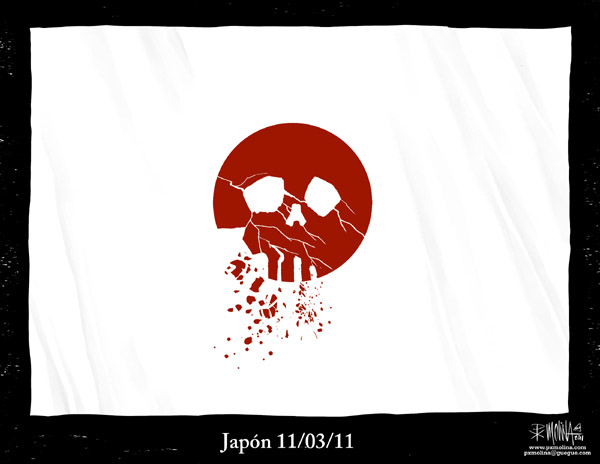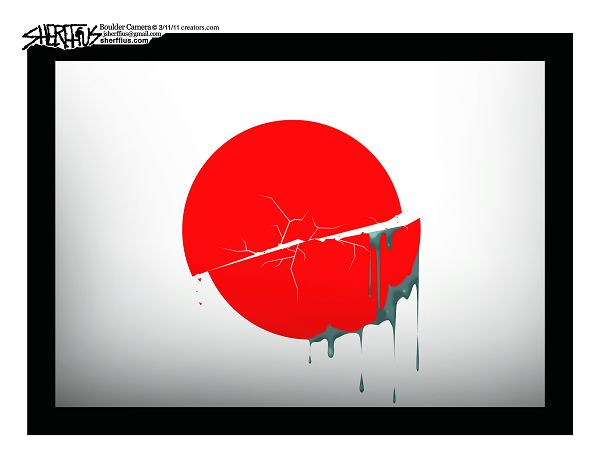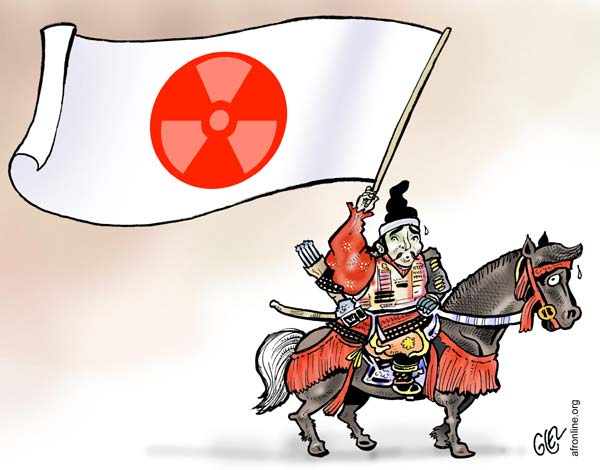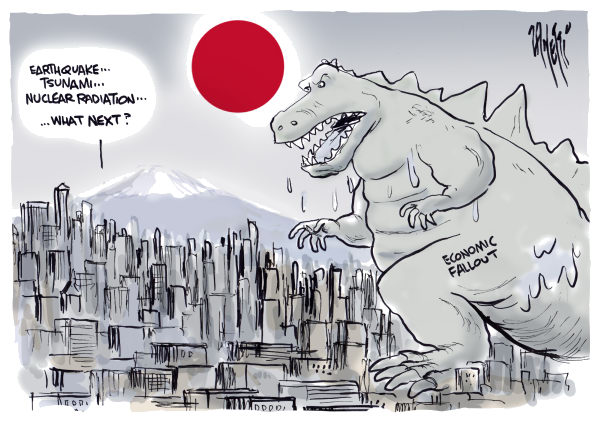
Pedro Molina, Managua, Nicaragua "El Nuevo Diario"
Ten days after the cataclysmic 8.9 earthquake in Japan, we have only a small sense of both the immediate and long-term consequences for the country. Political cartoonists world-wide are manipulating the image of the Japanese flag, positioning the crisis as a national tragedy/catastrophe and exploring the aftershocks. The resulting images are interesting for both their visual simplicity and the complex arguments they (inadvertently?) construct.
Addressing the pedagogical implications of images and tragedy, Megan's thoughtful post from Friday opens with another manipulated image of the Japanese flag in which the rising sun has morphed into a tear drop. That image highlights the sorrow of the tragedy - evoking global sympathy for a nation in crisis. Yet from another perspective, the image could also represent a drop of blood - acting as either a memorial for those who died or, theoretically, a call to arms. Though I doubt those are the intended readings, I merely want to point out that even fairly straightforward images can be sites of contestation.
The images above and below strike me as more overtly complex arguments about the disastrous consequences for the nation. In Molina's image, the sun is now a skull, cracked and disintegrating. While the image immediately points toward the massive death toll (8,450 dead and 12,931 missing at the time of writing), it also posits the disaster as crippling (and potentially lethal) for the nation as a whole.

John Sherffius, Colorado, Boulder Daily Camera
Various cartoonists have played with images of fracture and symbolic post-quake cracks, but Sherffius presents a sun severed completely in half. The image posits a rupture, with one half of the nation more grievously effected. Unlike the red teardrop which unifies the nation's grief, Sherffius' image points towards an irrevocable severance.
While the symbolic value of the flag makes it universally recognizable (and superficially simple to read), when cartoonists combine the flag with other "easily recognizable" symbols of Japan, the effects become more opaque.

Damien Glez, Journal du Jeudi, Ouagadougou, Burkina Faso
Several dozen representations of the Japanese flag combined with the radioactive symbol have emerged in the last week, but they are mostly presented as solitary images - either the flag itself or a deserted flagpole. Damien Glez, however, depicts an anxious samurai waiving the flag aloft. The image is troubling for the way in which it suggests a connection between the radiation crisis, military aggression (a warrior in full dress) and surrender (waiving a white flag). In the post-WWII fallout this image might have made more sense, but it seems both anachronistic and insensitive now.
Political cartoons inevitably exploit stereotypes for both simplicity's sake and for comedic value, but many of the cartoons emerging after the tsunami raise questions about our ability to access and comprehend foreign nations. While the Japanese flag and the image of Godzilla are certainly immediately recognizable, if these are the images through which we understand Japan, what does that say about us?

Paul Zanetti, Australia




Recent comments
2 years 29 weeks ago
2 years 44 weeks ago
2 years 44 weeks ago
2 years 50 weeks ago
3 years 4 weeks ago
3 years 4 weeks ago
3 years 4 weeks ago
3 years 6 weeks ago
3 years 6 weeks ago
3 years 6 weeks ago